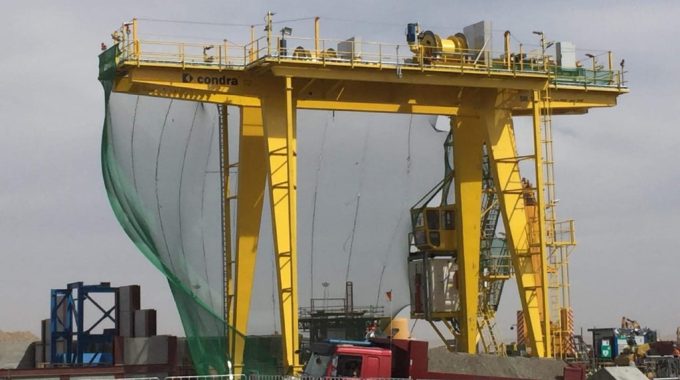Fully-automated Control Option from Condra Cranes
Post Series: Ultimate Blog Post Series
- 1.Fully-automated Control Option from Condra Cranes
Condra has announced a fully-automated overhead crane capability, simultaneously revealing details of its first delivery of this type of technically advanced machine to Lonmin.
An alternative to traditional pendant and remote control, full automation is in line with a general trend away from manual control in industry and mining.
Condra’s managing director, Marc Kleiner, said that the company was making full use of new developments in sensors, controls and software to offer a very precise positioning capability in automated applications.
“This is a capability that we will offer to our customers as an option,” Kleiner said.
“We will mainly but not solely target the copper mines, especially tankhouse and copper-leaching applications where we have extensive experience.”

Condra’s announcement follows the steadily increasing sophistication of its semi-automated installations, which began in 2003 with a grabbing crane installed at a Durban spice company to pick spices and transport them to specific points for release over hoppers servicing the blending and packing operations.
At Lonmin’s Marikana platinum mine, the fully-automated machine just installed is a 16-ton, 16 metre-span double-girder electric overhead travelling grabbing crane, featuring a customer-specified mechanical rope grab in place of the hydraulic alternative to deliver the improved durability of mechanical operation within Markina’s abrasive operating environment.
There are dual hoists in the design; one to raise and lower the load, the other to mechanically close the grab by means of an internal sheave arrangement to overcome the spring-loaded open state.
Variable speed drives are fitted throughout the crane, delivering maximum speeds of 10 metres per minute on the lift, and 20 and 40 metres per minute on the cross-travel and long-travel respectively. Four long-travel motors deliver the materials handling equivalent of four-wheel-drive, enabling automated control of all four wheels for precise crane positioning accurate to within 5 millimetres.
The crane is fully automated with a manual override.
Lonmin’s new crane is programmed by an operator from a remotely located control room, where on-screen monitoring is complemented by a visual monitoring capability via closed-circuit television.

Condra’s fully-automated option applies across the company’s product offering of single girder and double-girder overhead travelling cranes, gantry cranes, bridge cranes and cantilever cranes for markets worldwide.
These machines go up to heavy duty Class 4, with a tight focus on product quality and reliability to the standards of ISO, GOST and other internationally recognised quality control bodies.
Two lines of hoists are manufactured in a number of standard models suited to most mining, industrial and general applications, from 1 to 500 tons. Motors are bought from external suppliers.
Lonmin’s fully automated crane was delivered and commissioned in the last week of November 2019.
An alternative to traditional pendant and remote control, full automation is in line with a general trend away from manual control in industry and mining.
Condra’s managing director, Marc Kleiner, said that the company was making full use of new developments in sensors, controls and software to offer a very precise positioning capability in automated applications.
“This is a capability that we will offer to our customers as an option,” Kleiner said.
“We will mainly but not solely target the copper mines, especially tankhouse and copper-leaching applications where we have extensive experience.”

This fully-automated Condra crane, recently delivered to Lonmin’s Marikana mine, features a mechanical rope grab in place of the hydraulic alternative to deliver the improved durability of mechanical operation within Markina’s abrasive operating environment.
Condra’s announcement follows the steadily increasing sophistication of its semi-automated installations, which began in 2003 with a grabbing crane installed at a Durban spice company to pick spices and transport them to specific points for release over hoppers servicing the blending and packing operations.
At Lonmin’s Marikana platinum mine, the fully-automated machine just installed is a 16-ton, 16 metre-span double-girder electric overhead travelling grabbing crane, featuring a customer-specified mechanical rope grab in place of the hydraulic alternative to deliver the improved durability of mechanical operation within Markina’s abrasive operating environment.
There are dual hoists in the design; one to raise and lower the load, the other to mechanically close the grab by means of an internal sheave arrangement to overcome the spring-loaded open state.
Variable speed drives are fitted throughout the crane, delivering maximum speeds of 10 metres per minute on the lift, and 20 and 40 metres per minute on the cross-travel and long-travel respectively. Four long-travel motors deliver the materials handling equivalent of four-wheel-drive, enabling automated control of all four wheels for precise crane positioning accurate to within 5 millimetres.
The crane is fully automated with a manual override.
Lonmin’s new crane is programmed by an operator from a remotely located control room, where on-screen monitoring is complemented by a visual monitoring capability via closed-circuit television.

Condra is now offering a fully-automated control option across the company’s product offering of single girder and double-girder overhead travelling cranes, gantry cranes, bridge cranes and cantilever machines.
Condra’s fully-automated option applies across the company’s product offering of single girder and double-girder overhead travelling cranes, gantry cranes, bridge cranes and cantilever cranes for markets worldwide.
These machines go up to heavy duty Class 4, with a tight focus on product quality and reliability to the standards of ISO, GOST and other internationally recognised quality control bodies.
Two lines of hoists are manufactured in a number of standard models suited to most mining, industrial and general applications, from 1 to 500 tons. Motors are bought from external suppliers.
Lonmin’s fully automated crane was delivered and commissioned in the last week of November 2019.


